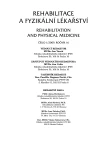-
Medical journals
- Career
What is the Way of Vojta’s Method Functioning
Authors: I. Vařeka 1,2; R. Dvořák 2
Authors‘ workplace: Lázně Luhačovice, a. s., Luhačovice ; vedoucí lékař prim. MUDr. J. Hnátek Katedra fyzioterapie FTK UP, Olomouc 1; vedoucí katedry prof. MUDr. J. Opavský, CSc. 2
Published in: Rehabil. fyz. Lék., 16, 2009, No. 1, pp. 3-5.
Category: Original Papers
Overview
The Vojta’s reflex locomotion is an acknowledged diagnostic and therapeutic system which
can bring about favorable results as soon as adequate indication and mastering difficult technique is provided. The classical explanation of the mechanism of effect is based on presumed existence of existence of inborn motor patterns, which are activated by adequate stimulation of activating points/zones by application of the therapist’s pressure in previously set position. The authors offer alternative explanation pointing out motor learning, where the previously set position and pressure/resistance of the therapist participates in: 1. demarcation and supplementation of the supporting basis, 2. continuous initiation and guidance of the motion and 3. directed limitation of the spectrum of possible motor responses.Key words:
Vojta’s reflex locomotion, motor paradigms, reflex events, DOF – dynamic system, posture
Sources
1. ČÁPOVÁ. J.: Terapeutický koncept. Bazální programy a podprogramy. Ostrava, Repronis, 2008.
2. DVOŘÁK, R.: Některé teoretické poznámky k problematice otevřených a uzavřených biomechanických řetězců. Rehabil. fyz. Lék., 12, 2005, č. 1, s. 12-17.
3. DVOŘÁK, R.: Otevřené a uzavřené biomechanické řetězce v kinezioterapeutické praxi. Rehabil. fyz. Lék., 12, 2005, č. 1, s. 18-22.
4. KOLÁŘ, P.: Význam vývojové kineziologie pro manuální medicínu. Rehabil. fyz. Lék., 3, 1996, č. 4, s. 152-155.
5. KOLÁŘ, P.: Senzimotorická podstata posturálních funkcí jako základ pro nové přístupy ve fyzioterapii. Rehabil. fyz. Lék., 5, 1998, č. 4, s. 142-147.
6. KOLÁŘOVÁ, J.: Je Vojtova metoda i v současné době nedonošenec, který musí o svůj život bojovat? Rehabilitácia, 34, 2001, č. 3, s. 182-181.
7. PAVLŮ, D., VÉLE, F., HAVLÍČKOVÁ, L.: Elektromyografická a kineziologická analýza Vojtova terapeutického principu. Rehabil. fyz. Lék., 7, 2000, č. 2, s. 74-77.
8. VAŘEKA, I.: Odpověď. Rehabilitácia, 34, 2001, č. 4, s. 204-205.
9. VAŘEKA, I..: Revize výkladu průběhu motorického vývoje - novorozenecké období až holokinetické stadium. Rehabil. fyz. Lék., 13, 2006, č. 2, s. 74-91.
10. VAŘEKA, I.: Revize výkladu průběhu motorického vývoje - monokinetické stadium až batolecí období. Rehabil. fyz. Lék., 13, 2006, 2, s. 82-91.
11. VOJTA, V., PETERS, A.: Vojtův princip. Praha, Grada (Avicenum), 1995.
12. THELEN, E., SMITH, L. B.: Dynamic systems theories. In Damon,W., Lerner, R. M. (Eds.), Handbook of child psychology. Vol. 1, Theoretical models of human development (s. 258-312). Hoboken, NJ, Wiley, 2006.
Labels
Physiotherapist, university degree Rehabilitation Sports medicine
Article was published inRehabilitation & Physical Medicine

2009 Issue 1-
All articles in this issue
- What is the Way of Vojta’s Method Functioning
- New Trends in Multiple Sclerosis
- Evaluating Hand Motor Performance in a Chronic Stage after Brain Stroke – Finger Tapping Test
- Vertebrobasilar Complications in Manipulation Treatment of Cervical Spine
- Is the Massage Really as Important as Supposed?
- Psychosocial Risk Factors in Rehabilitation Patients with Cardiovascular Diseases
- Comparison of Efficient Mud Bath Tub and Mud Wraps in an Alternative Way
- Awareness of Mothers about Motor Development of the Child until the Period of Reaching Bipedal Locomotion
- Rehabilitation & Physical Medicine
- Journal archive
- Current issue
- Online only
- About the journal
Most read in this issue- Evaluating Hand Motor Performance in a Chronic Stage after Brain Stroke – Finger Tapping Test
- Vertebrobasilar Complications in Manipulation Treatment of Cervical Spine
- What is the Way of Vojta’s Method Functioning
- Comparison of Efficient Mud Bath Tub and Mud Wraps in an Alternative Way
Login#ADS_BOTTOM_SCRIPTS#Forgotten passwordEnter the email address that you registered with. We will send you instructions on how to set a new password.
- Career

